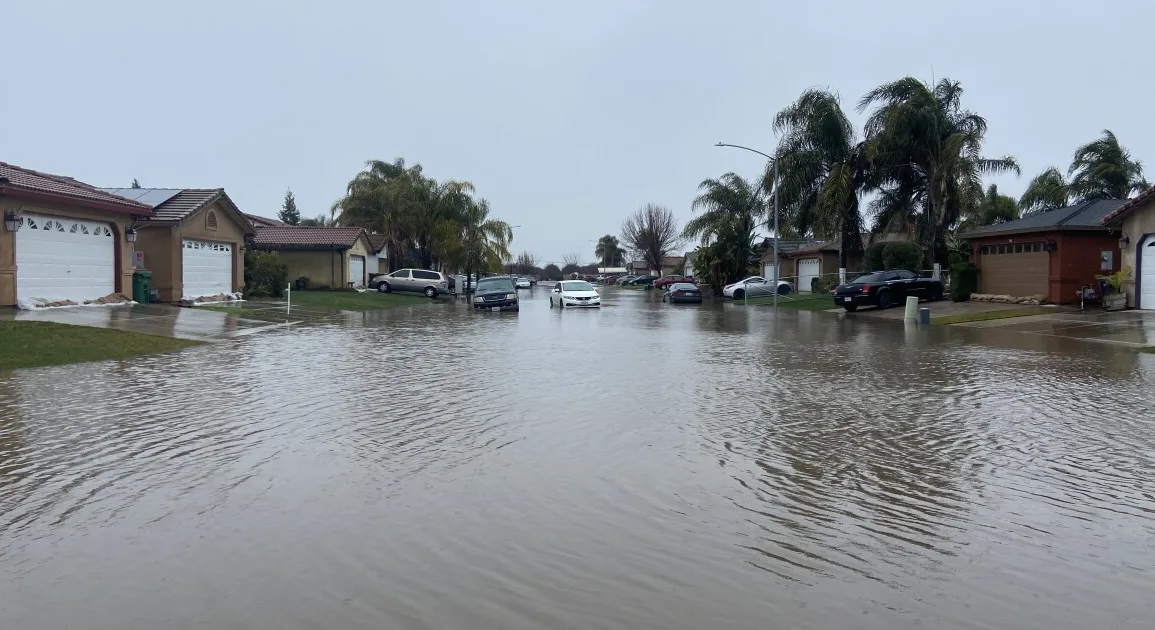The atmospheric river storms at the start of the year inundated several communities across the Central Valley. In this interview, KVPR’s Elizabeth Arakelian and Esther Quintanilla discuss the long-lasting impacts of the flood and the challenges facing Planada residents who need to rebuild their homes. One of the main concerns is the “bloom” of black mold, according to local organizations.
Listen to this report in the player on this page. Read the transcript below.
To read previous coverage of the 2023 Central Valley floods, click here.
ELIZABETH ARAKELIAN, HOST: It’s been more than six months since the big flood in the tiny Merced County community of Planada. And while residents have been slowly rebuilding their homes, the combination of lingering moisture and summer heat may cause some new complications. I sat down with KVPR reporter Esther Quintanilla and asked her to remind us of what exactly happened to the small town this past winter.
ESTHER QUINTANILLA: At the beginning of the year the community was thoroughly drenched during the atmospheric river storms. A levee failed on the night of January 9, and caused floodwater to rush into neighborhoods.
ARAKELIAN: Can you tell me about Planada?
QUINTANILLA: The community is largely Latino, and most primarily speak Spanish at home. Most of the residents are farmworking and many are undocumented.
ARAKELIAN: How did people react to the emergency?
QUINTANILLA: There was a mandatory evacuation order for about three days while county emergency services assessed storm damage. Those three days were a difficult time. People were worried about their belongings, their jobs, their entire livelihoods.
ARAKELIAN: Can you talk about what exactly was lost in the flood?
QUINTANILLA: In the weeks following the flood, UC Merced’s Community and Labor Center conducted a study to quantify the damages. Researchers found that more than 700 households, 700 families, experienced some form of economic loss after the flood. That’s more than 80% of Planada’s population.
ARAKELIAN: And what did the study say about people’s homes?
QUINTANILLA: It found that the vast majority of people did not completely dry out their homes with industrial dehumidifiers. That means that many, if not all, of those homes stayed damp for a long time. I obtained documents from county inspections that described mold being found in drywall, baseboards, insulation… almost every part of some houses.
ARAKELIAN: So I take it that mold is going to be a long-term issue for Planada residents?
QUINTANILLA: Absolutely, it’s one of the biggest issues folks are dealing with now. I spoke with Anita Hellam, the CEO of Habitat for Humanity in Merced and Stanislaus counties, which has been on the ground in Planada since the flood. She says that a lot of families didn’t have much information on how to fix their homes. Some of them even constructed over moldy infrastructure, which Hellam says can be dangerous.
ANITA HELLAM: If they put sheetrock up over a wet frame, and they put the insulation in wet, they’re going to have a big problem. Mold is going to be blooming inside the structure.
ARAKELIAN: And what happens if a home has moldy infrastructure?
QUINTANILLA: Mold can be really easy to overlook if it’s behind drywall or underneath floorboards. And when people have built on top of a wet frame or weakened foundation, they have had no choice but to start the reconstruction process from scratch a second time. Hellam says she’s concerned this will become a recurring issue for residents because mold only needs a bit of moisture and warmth to spread through the home.
ARAKELIAN: What are the health impacts of living with mold?
QUINTANILLA: Once it’s spread, mold can cause some serious health issues. In Central Valley communities like Planada, there’s already poor air quality and high rates of asthma and diabetes. I spoke with Dr. Michael Schmeltz, a public health professor at Cal State East Bay. He says long-term mold exposure will make those chronic health conditions worse.
MICHAEL SCHMELTZ: And that stress can potentially lead to long-term issues, meaning more asthma triggers, more visits to the E.R., more hospitalizations if things are severe.
ARAKLELIAN: Where can people find more information about mold exposure?
QUINTANILLA: There are guides available on the state public health website, and more detailed information from the CDC.
ARAKELIAN: Thanks for joining me today, Esther.
QUINTANILLA: Always a pleasure, Liz.
ARAKELIAN: If you’ve had mold issues after this year’s floods, KVPR would like to hear from you. You can reach us at talk@kvpr.org



